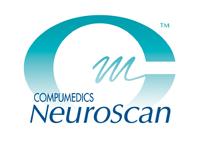Case Study: Compumedics NeuroScan & Polhemus FASTRAK enables Medical Research Applications
Using Polhemus technology, NeuroScan was able to be the first in the industry to produce a three dimensional image of a subject's head. "For the first time, we can quickly take EEG data and overlay it on a MR image for an exact definition of where electrical activity is coming," said Stephen Sands, Chief Scientist.

Background: Compumedics NeuroScan, formerly known as NeuroScan, Inc., was established in 1988 to pursue the development and sale of advanced computer software and apparatus to assist in understanding the electrophysiological functioning of the brain.
The company has expanded its focus to now provide products for the new topic of "multimodal neuroimaging," encompassing electrophysiological technology (EEG and Evoked Potentials), magnetic resonance imaging (MRI, both functional and anatomical), positron emission tomography (PET), magnetoencephalography (MEG) and computer tomography (CT). The company's mission is to provide neuroimaging for medical research.
The Polhemus Motion Capture Solution
In 1992, NeuroScan received a contract from the National Institute of Neurological Disorders and Strokes (a division of the National Institute of Health) to build the first commercial 128 channel EEG/EP system. As part of this new system, NeuroScan made the decision to incorporate into the product exact electrode placement on the head to provide the highest quality and most accurate recording available.
After researching products on the market that would aid them in building this high accuracy component, NeuroScan selected the Polhemus ISOTRAK™ solution, a 3D motion tracking and digitizing system. Later, with the introduction of the Polhemus FASTRAK®, a system offering higher speed and accuracy, NeuroScan decided to upgrade to incorporate the highest accuracy system on the market.
Using Polhemus technology, NeuroScan was the first in the industry to produce a 3D image of a subject's head and define the exact location of electrodes placed on the subject.
The Polhemus Advantage
"For the first time we can quickly take EEG data and overlay it on a MR image for an exact definition of where electrical activity is coming," said Dr. Stephen Sands, Chief Scientist. "Before using Polhemus' solutions, this was a long and difficult process to accurately calculate this activity."
For example, the Polhemus data can be read by its new Current Reconstruction and Imaging (CURRY) software. CURRY is a powerful package which allows users to combine the results of EEG/MEG measurements with image modalities such as MRI and CT. The result is a realistic 3D view of brain electrical activity.
"MRI takes a snapshot of the brain at every second, giving a read out of the structure of the brain," said Sands. "While EEG works in milliseconds, which allows one to view the brain as it is actually functioning; by combining the two, you have a more accurate understanding of the brain's activity. Using Polhemus within our products, we are taking several steps forward in better understanding how the brain works."
FASTRAK is an award-winning 3D motion tracking and digitizing system that offers high speed, high accuracy, and low latency using one to four receivers for medical, animation, simulation and motion capture applications. Because accuracy was critical to NeuroScan's needs, the FASTRAK was an ideal solution.
"With FASTRAK, we believe we have the highest accuracy solution, bar none. Accuracy is imperative to the success of our products and is particularly important when understanding the brain." Dr. Stephen Sands
Summary
NeuroScan has achieved great success using Polhemus' solutions. Today, NeuroScan's products are used by over 1500 leading universities and research institutes around the world.
"We look forward to working with Polhemus products," said Sands. "We have been very happy with not only the products themselves, but also with the technical support as well. We will continue to work closely with Polhemus in our future endeavors."
Learn More:
- FASTRAK
- Download PDF
- Contact sales@polhemus.com for product information.

